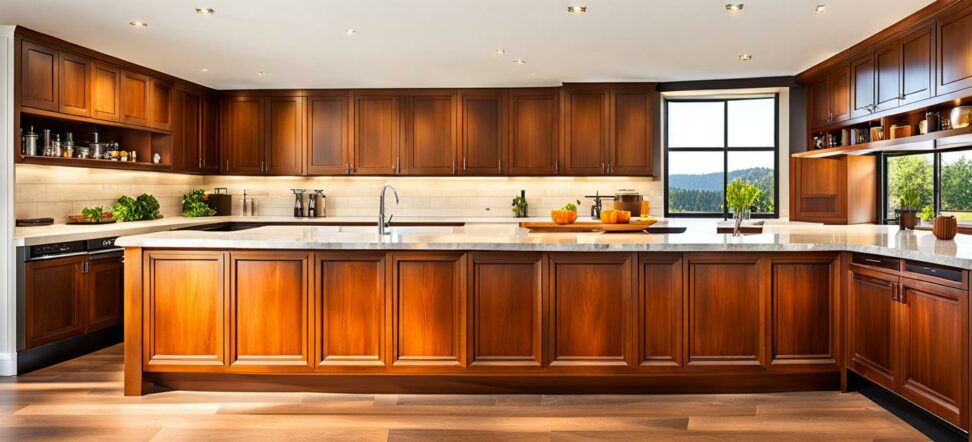Choose the Perfect Kitchen Cabinet Stain for Your Style
With its rich colors and textures, cabinet stain transforms the heart of your home. The right stain elevates your kitchen's style while showcasing the natural beauty of wood.
But with so many options, from deep espresso tones to light driftwood grays, how do you pick the perfect color?

Popular Kitchen Cabinet Stain Colors
When browsing stain colors, three lush, dark brown hues stand out for their sophistication and versatility.
Rich, Dark Browns
Espresso evokes a refined, elegant aesthetic with its saturated, dark brown coloring. The daring shade feels intimate and cozy in small spaces.
With its warm milk chocolate tones, mocha creates a welcoming, lived-in look. Mocha's flexibility allows it to fit modern, traditional, or rustic styles.
For a natural yet bold statement, java offers a balanced medium-dark brown. The crisp color pairs nicely with both light and dark cabinetry.
Light Tans and Browns
If you prefer a brighter, more airy look, popular lighter brown stains include oak and cappuccino.
Oak celebrates the wood's natural grain patterns in shades of tan and brown. It brings visual interest through variation in tone and texture.
With its latte-inspired hue, cappuccino adds a touch of warmth without overpowering the space. The soft beige-brown works well for cottages or farmhouses.
Natural Wood Tones
For those who want the wood to take center stage, maple, cherry, walnut, and hickory embrace the material's inherent beauty.
Maple offers a contemporary, uniform appearance with its tightly grained, pale blond surface. The muted color enhances other elements.
With fine, reddish-brown graining, cherry stains reveal subtle natural highlights. Cherry adds a casual elegance to Shaker or Craftsman decor.
Prized for its luxurious colors, walnut stains in varying rich browns with darker brown streaking. The fluid, dynamic patterns create depth.
Ranging from reddish brown to tan, hickory offers lighter colors yet strong wood figure. The varied grain provides visual dynamism.
Factors That Impact Stain Color
While personal taste drives stain selection, several factors affect how color turns out. Consider the following elements.
Types of Wood
Softwoods like pine absorb less stain and yield a lighter end result than dense hardwoods. Open-grained woods like oak or ash allow more stain penetration versus closed-grain maple or cherry.
The natural shade of the raw wood impacts the final color. Stain appears darker on lighter woods and lighter on darker woods.
Stain Type
Pigment stains sit on the wood's surface while dye stains penetrate the pores. Dyes enhance grain visibility. Oil-based stains soak deeper than water-based versions.
Semi-transparent options showcase some grain through thin coloring. Opaque stains completely mask the substrate beneath solid pigment.
Finishes
Polyurethane seals in stain and provides a protective sheen. Satin or matte finishes mute color intensity versus higher gloss.
Applying stain wax after staining enriches depth and offers a smooth patina. Wax also allows touch-ups down the road.
Stain Color Selection Strategies
Beyond personal preference, a few simple strategies guide stain decisions.
Complement Architecture and Style
Select cabinetry stain colors that coordinate with your home's external materials and interior trimwork. Contrasting or matching your design scheme creates intentionality.
Factor in the overall style too - lighter stains suit airy cottages while darker moody stains complement industrial and contemporary spaces.
Coordinate with Cabinets and Countertops
Tying cabinet stain to countertop finishes grounds the kitchen's look. Or, use contrasting stain and counter colors to define zones.
For example, stain base cabinets a deep espresso and leave island cabinets natural for interest. Granite counters could tie the two together.
Set Kitchen Mood and Atmosphere
Light, neutral cabinet stains keep cooking spaces feeling open and casual. Darker colors cocoon smaller kitchens in coziness and intimacy.
Stains showcasing wood grain bring warmth and natural texture. More opaque solid stains make a crisp, contemporary statement.
Application Tips and Tricks
Though staining may seem straightforward, proper prep and technique ensure success.
Prep and Condition Wood
Thoroughly clean cabinets then sand using 220 grit sandpaper to rough up the surface. Fill any imperfections with wood filler and re-sand.
For the smoothest application, apply pre-stain conditioner following the grain before staining. This controls absorption.
Proper Brush Techniques
Use a high-quality natural bristle stain brush. Maintain a “wet edge” and work from board to board quickly to prevent lap marks. Always brush along the wood grain.
Wipe the entire surface with a clean cloth to even out the stain. Remove excess from edges and corners.
Seal and Protect the Finish
Let stain cure fully - usually 24-48 hours. Then apply 2-3 coats of satin polyurethane, sanding lightly between coats.
A final buff with extra-fine steel wool gives a smooth feel. Replace hardware and the boxes, enjoying your revamped heart of the home.
With the right stain color that complements your style, cabinets become a focal point. Now that you know how to pick the perfect stain for your kitchen, you can elevate it from basic to beautiful.
Start by sampling a few potential colors on interior cabinet boxes before committing. Soon you’ll be crafting a personalized palette that brings warmth, elegance or versatility to this essential space.